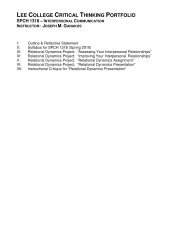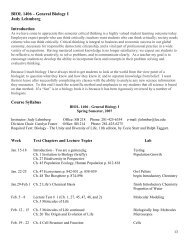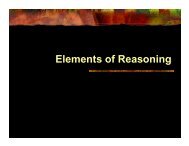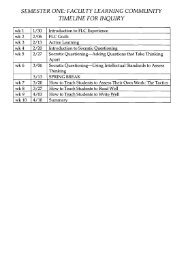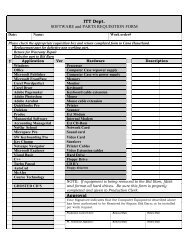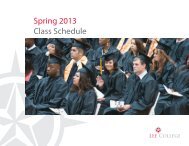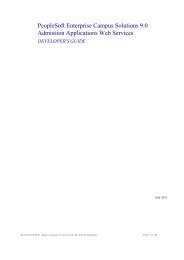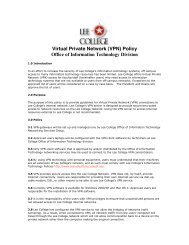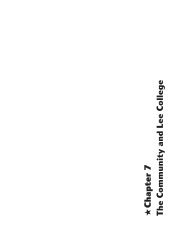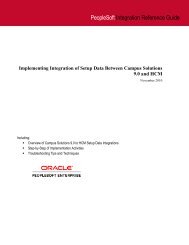Candidate's Statement on Teaching - Lee College
Candidate's Statement on Teaching - Lee College
Candidate's Statement on Teaching - Lee College
Create successful ePaper yourself
Turn your PDF publications into a flip-book with our unique Google optimized e-Paper software.
<strong>Teaching</strong> Portfolio for Faculty Learning Community #3<br />
Scott Nunez<br />
Table of c<strong>on</strong>tents<br />
Page 2<br />
<strong>Teaching</strong> Philosophy<br />
Page 3 Example syllabus for Microbiology Biol 2421<br />
Page 15 Critical thinking exercise #1: Hardware phylogeny exercise<br />
Page 16 Critical thinking exercise #2: Build-a-Bacterium<br />
Page 17 Critical thinking exercise #3: Microbiology Bingo<br />
Page 18 Evaluati<strong>on</strong> of Instructor by Supplemental Instructor (Fall 2009)
<strong>Teaching</strong> Philosophy<br />
The key to effective teaching at the college level lies in creating an envir<strong>on</strong>ment which<br />
allows an open exchange of knowledge and active participati<strong>on</strong> by students. Because so much<br />
time and effort is put into teaching, instructors develop a sense of ownership about their courses.<br />
This mentality can give the unintended impressi<strong>on</strong> that knowledge itself is owned and that<br />
instructors are merely informati<strong>on</strong> vendors. To counteract this, my teaching mentors always<br />
stressed that instructors should not promote themselves as infallible, but as mediators of<br />
informati<strong>on</strong>, as accessible sources of knowledge and experience. Instructors must encourage<br />
students to move away from rote memorizati<strong>on</strong> towards active thought and comprehensi<strong>on</strong>.<br />
Developing a relaxed, respectful rapport with students is critical to these goals.<br />
Many undergraduates find it easier to be passive in the classroom. This can be overcome<br />
somewhat by engaging students with questi<strong>on</strong>s and drawing out their interests and perspectives.<br />
Because different students learn in different ways, diverse teaching and evaluati<strong>on</strong> methods<br />
should be used to reach the auditory, visual, and kinestetic learners. Powerpoint presentati<strong>on</strong>s,<br />
the internet and other technology can create frameworks for classroom discussi<strong>on</strong>s. For<br />
example, because there is a wealth of informati<strong>on</strong> (including images and video) about diseases<br />
and medical advances, the internet is particularly useful when discussing pathological states.<br />
Students should be encouraged to fill in this framework with pertinent, productive and<br />
informative tangential discussi<strong>on</strong>s. Because creativity and humor are powerful ways to spark<br />
such discussi<strong>on</strong>s, humorous presentati<strong>on</strong>s <strong>on</strong> subject matter can help to introduce c<strong>on</strong>cepts and<br />
terminology most courses.<br />
Active learning exercises, where students have the opportunity to get up and move<br />
around (sometimes moving outside of the classroom) can stimulate thought and discussi<strong>on</strong>.<br />
Laboratory exercises can be particularly useful, as they can help overcome student passivity and<br />
aid in c<strong>on</strong>necting science to everyday life, an important motivati<strong>on</strong> for many students.<br />
In any academic setting, students must be challenged to do more than they think<br />
themselves capable. In offering this challenge, instructors must be willing to go the extra mile to<br />
assist students who accept it. Most importantly, giving students a voice in their educati<strong>on</strong> and<br />
the freedom to pursue their individual academic interests eventually leads to students who, like<br />
their instructors, develop an ownership mentality towards their classes that maximizes their<br />
educati<strong>on</strong>al experience.
Secti<strong>on</strong> I: Example Syllabus<br />
Microbiology<br />
Biology 2421<br />
Class numbers 11219 and 11221<br />
Summer Semester 2009<br />
Class will meet <strong>on</strong> Tuesdays and Thursdays:<br />
M11: 9:10A to 1:20P<br />
M12: 5:45P to 9:55P<br />
Instructor<br />
Dr. Scott Nunez<br />
Office<br />
SB227 and SB228<br />
Office hours Tuesdays and Thursdays 2:00-5:00P or by appointment<br />
Ph<strong>on</strong>e 832-556-4510<br />
Email<br />
bnunez@lee.edu<br />
Divisi<strong>on</strong> Chair: Tom O’Kuma (281-425-6522; SB 215)<br />
Divisi<strong>on</strong> Secretary: Janice Martin (281-425-6332; SB 219)<br />
Course overview: Biol 2421 provides a broad overview of the general biology of microorganisms.<br />
While special attenti<strong>on</strong> will be paid to medical microbiology, this course is designed to introduce you to<br />
the world of microbiology as a whole, and will therefore also examine ecological and envir<strong>on</strong>mental<br />
aspects of microbiology.<br />
Required text: Foundati<strong>on</strong>s in Microbiology, Kathleen Park Talaro, 7 th Editi<strong>on</strong>, McGraw-Hill<br />
Companies, Inc., 2009<br />
Required lab manual: Microbiology Laboratory: Theory & Applicati<strong>on</strong>: Brief Editi<strong>on</strong> Michael J.<br />
Leboffe and Burt<strong>on</strong> E. Pierce, Mort<strong>on</strong> Publishing, 2008.<br />
Lab jacket and closed-toed shoes are REQUIRED! No jacket, no shoes, no lab.<br />
Additi<strong>on</strong>al References and Resources:<br />
A Photographic Atlas for the Microbiology Laboratory, Michael J. Leboffe and Burt<strong>on</strong> E. Pierce, Mort<strong>on</strong><br />
Publishers<br />
Microbiology Laboratory Exercises, Short Versi<strong>on</strong>, Margaret Barnett, W.C. Brown Publishers<br />
Journal Watch Infectious Diseases, Massachusetts Medical Society.<br />
Centers for Disease C<strong>on</strong>trol and Preventi<strong>on</strong>: www.cdc.gov<br />
World Health Organizati<strong>on</strong>: http://www.who.int/en/<br />
Informati<strong>on</strong> will be posted <strong>on</strong> Blackboard, check it early, check it often.<br />
A note about the Blackboard discussi<strong>on</strong> board:<br />
The discussi<strong>on</strong> board is a great way to have c<strong>on</strong>versati<strong>on</strong>s about microbiology, but the an<strong>on</strong>ymity<br />
of the computer may remove many inhibiti<strong>on</strong>s and lead to off-topic and/or impolite discussi<strong>on</strong>s. The<br />
board will be kept civil by force, I will remove any pers<strong>on</strong>al attacks and uncivil posts. Please report abuse<br />
to me; I am the <strong>on</strong>ly authority <strong>on</strong> this board and there should be no other policemen. Individuals may<br />
lose Blackboard privileges if a persistent problem develops.<br />
Course requirements<br />
Attendance
You are to sign into class when you arrive and out when you leave. Attendance is defined as arriving to<br />
class <strong>on</strong> time (preferably early) and staying the entire class period.<br />
Carrots: Those that choose to arrive <strong>on</strong> time, take part in class, and leave at the appropriate time:<br />
-will be eligible for extra credit exercises.<br />
-will benefit fully from class discussi<strong>on</strong>s and exercises.<br />
- I retain the right to adjust scores upward by as much as three points (no lobbying); somewhat predicated<br />
by your attendance (perfect attendance eligible for 3 pts; <strong>on</strong>e absence 2 pts; two absences 1 pt)<br />
Sticks: Those that choose to arrive late and/or leave early:<br />
-will not receive credit for attendance.<br />
-will not be eligible for extra credit pop quizzes and exercises.<br />
-will not benefit fully from class discussi<strong>on</strong>s and exercises; grades will suffer accordingly.<br />
-may be dropped from the class if you miss three or more sessi<strong>on</strong>s.<br />
-will not do well if you do not attend class.<br />
Your evaluati<strong>on</strong><br />
You will be evaluated in both lecture (60%) and laboratory (40%). The exercises used to calculate your<br />
final grade will c<strong>on</strong>sist of:<br />
Lecture:<br />
In-class exams: There will be FIVE in-class lecture exams and <strong>on</strong>e final exam. Exams will be<br />
cumulative and will increase in value sequentially for a total of 490 points.<br />
Exam 1 (short) June 16 th 40 points<br />
Exam 2 (short) June 25 th 60 points<br />
Exam 3 (short) July 7 th 80 points<br />
Exam 4 (short) July 16 th 90 points<br />
Exam 5 (l<strong>on</strong>g) July 28 th 100 points<br />
Exam 6 (required) August 27 th 120 points<br />
There are no make-up exams, if you miss an exam, the next exam you take will be worth the sum of those<br />
two exams. For example, if you miss exam 1 (worth 40 points) then exam 2 will be worth 90 points. If<br />
you miss more than two exams you will be dropped from the course. You must take the final exam.<br />
Extra work: These exercises will EACH be worth 10 points that can be used toward your<br />
lecture exam total. In additi<strong>on</strong> to unannounced in-class quizzes (be prepared!), you will have the<br />
opportunity to present oral and written summaries of scientific papers (to be approved by your instructor)<br />
for a total of 50 points. Oral presentati<strong>on</strong>s will be 10 minutes l<strong>on</strong>g at the beginning of class <strong>on</strong> a topic of<br />
the instructor’s choosing or approval. Your grade will be determined by the class as a whole. Written<br />
summaries of an article of the instructor’s choosing or approval will be a minimum of <strong>on</strong>e page double<br />
spaced clearly stating the objective of the paper, the methods used, the results of the experiments and the<br />
significance of the work. Extra work will not be accepted after August 18 th .<br />
Review paper (110 total points): You will prepare a short paper that reviews the biology and<br />
pathology of a disease-causing microorganism. The assignments are:<br />
1 st assignment: Outline (10 points); due June 18 th .<br />
2 nd assignment: Rough draft (40 points); due July 18 th .<br />
3 rd assignment: Final paper (60 points); due August 6 th .<br />
1. Papers must be typed in the following format: 1” margins (top, bottom, and both sides), 12 point f<strong>on</strong>t,<br />
and double spaced in any comm<strong>on</strong> f<strong>on</strong>t.<br />
2. The paper (introducti<strong>on</strong>, body of the paper, and c<strong>on</strong>clusi<strong>on</strong>) must more than 4 pages l<strong>on</strong>g, less than 6
pages l<strong>on</strong>g, in the above format. This does not include the cover page or the works cited page.<br />
3. At least five reputable sources must be cited in your paper; be cautious of older papers, they may not<br />
c<strong>on</strong>tain c<strong>on</strong>temporary informati<strong>on</strong> about your subject.<br />
Try these:<br />
http://journals.asm.org/minireviews.shtml {this site is a searchable index of minireviews, great place to<br />
start!}<br />
Microbiology and Molecular Biology Reviews {another site with good review articles}<br />
Applied and Envir<strong>on</strong>mental Microbiology<br />
Journal of Microbiology<br />
Journal of Clinical Microbiology<br />
Microbiology<br />
This is just a sample; there are a t<strong>on</strong> of microbiology journals out there, so no excuses!<br />
YOU CANNOT USE WEB SITES AS SOURCES. Your textbook does not count either.<br />
4. Paper structure:<br />
a. Cover page: Includes informative title, your name, date, and the class (Biology 2421<br />
Microbiology). ALSO have an abstract, which is a short summary of the paper. The abstract follows the<br />
outline of the whole paper (beginning to end), but does not go into detail. It should be interesting (“grabs<br />
the reader’s attenti<strong>on</strong>”), includes the main topic (the pathogen and disease) and previews the structure of<br />
the paper (what you plan to discuss in the paper). REMEMBER: This does not count in the page total.<br />
b. Paper Body (should be fully cited!)<br />
i. Introductory secti<strong>on</strong>- Can include:<br />
• Scientific name (Genus and species) and comm<strong>on</strong> name of the pathogen<br />
• Name of the disease or diseases it causes<br />
• Brief history, interesting informati<strong>on</strong> about the pathogen or disease<br />
ii. Descriptive secti<strong>on</strong>s- describes the disease including:<br />
• Anatomical and physiological descripti<strong>on</strong> of the pathogen<br />
• Chain of infecti<strong>on</strong> (mode of transmissi<strong>on</strong>)<br />
• Frequency and distributi<strong>on</strong> of the pathogen/disease in the U.S. and in the world<br />
• Within a populati<strong>on</strong>, describe any trends <strong>on</strong> who gets the disease (by race, age, etc)<br />
• How does the pathogen cause the disease?<br />
• What parts of the body are affected by the disease?<br />
• Symptoms of the disease<br />
• Treatment of the disease and vaccinati<strong>on</strong> (if applicable)<br />
• Preventi<strong>on</strong><br />
iii. C<strong>on</strong>clusi<strong>on</strong> paragraph- Restates the main topic (pathogen and disease) & summarizes<br />
main points<br />
c. Works cited page- includes all books, magazines, etc that were cited in your paper.<br />
5. You must cite all factual informati<strong>on</strong> in your paper. It is better to assume that you must cite something<br />
than to not give credit to the source. Citati<strong>on</strong>s are designed to give credit to the author whose informati<strong>on</strong><br />
you are using.<br />
Direct quotes of sentences or paragraphs are NOT allowed in this paper. Reword everything<br />
into your own words. Any excepti<strong>on</strong>s must be approved before you turn in the paper by the
instructor. However, even if you reword the sentence, you still must give credit to the source<br />
using citati<strong>on</strong>s.<br />
See www.dianahacker.com/resdoc/p04_c11_s2.html for the format of your works cited page and<br />
examples of each type of citati<strong>on</strong>. Use the “name-year” method. This is a very easy citati<strong>on</strong><br />
method where you cite informati<strong>on</strong> in your paper by giving the authors last name and the date of<br />
publicati<strong>on</strong>. Examples:<br />
One out of every five people carry this opportunistic pathogen (Smith, 1999).<br />
OR<br />
Nunez (2003) later recognized that women are much more likely to c<strong>on</strong>tract the disease.<br />
If the article does not have an author, use the title of the article, placed in quotes, in its place. For<br />
example:<br />
The pathogen is easily treated using penicillin (“The history of infectious disease”, 2005).<br />
OR<br />
As stated in the article “The history of infectious disease” (2005), penicillin is often used to treat bacterial<br />
infecti<strong>on</strong>s.<br />
Your outline and draft will be submitted electr<strong>on</strong>ically as Microsoft Word documents. Include ALL<br />
secti<strong>on</strong>s (cover page, paper body, and citati<strong>on</strong>s) in a single file and name that file yourlastnameoutline and<br />
yourlastnamedraft. I will send it back to you if it is not in this format.<br />
Paper evaluati<strong>on</strong>: While c<strong>on</strong>tent is my main c<strong>on</strong>siderati<strong>on</strong>, I will count off for spelling and grammar<br />
(0.25 point for each infracti<strong>on</strong> in outlines and drafts; 1 point for each infracti<strong>on</strong> in final papers), so<br />
proofread your documents. Late documents will be assessed a 10 point deducti<strong>on</strong> for each day late. Your<br />
final paper should be a hard copy, due at the START of class <strong>on</strong> the due day.<br />
According to the American Heritage Dicti<strong>on</strong>ary, plagiarism is defined as “appropriating for use as <strong>on</strong>e’s<br />
own passages or ideas from another”; in other words taking some<strong>on</strong>e’s ideas or words without giving<br />
them credit. Acts of plagiarism will result in reducti<strong>on</strong> in your score. If you wish more informati<strong>on</strong> about<br />
plagiarism, please visit: http://owl.english.purdue.edu/handouts/research/r_plagiar.html<br />
NO CUTTING AND PASTING!!!<br />
Laboratory Evaluati<strong>on</strong><br />
Lab exercises: Each laboratory exercise will have both active and written comp<strong>on</strong>ents. The lab<br />
manual is required; your lab manual will outline each exercise, provide questi<strong>on</strong>s with which to test<br />
yourself and a list of objectives and questi<strong>on</strong>s regarding the laboratory exercise. The majority of the<br />
laboratory part of this course is built around the identificati<strong>on</strong> of an unknown microorganism. You must<br />
provide a three-ring binder to put both your lab manual and your lab notebook in. Each week we will be<br />
learning new techniques, many of which you will use repeatedly. You will record IN INK any notes<br />
regarding these techniques and the results of each assay that you perform in this notebook. Your goal is<br />
to gather as much informati<strong>on</strong> about your microorganism as you can in pursuit of its identity. YOU<br />
MUST MAINTAIN YOUR LAB BOOK! If you do not write it down, you will forget it!<br />
Lab notebooks grades determined <strong>on</strong> June 30 th (50 points), July 21 st (100 points), and August11 th (100<br />
points).<br />
Lab practicals: Lab practical exams will be held <strong>on</strong> July 14 th (50 points) and August 11 th (100<br />
points) during which your mastery of the informati<strong>on</strong> and techniques associated with the laboratory<br />
exercises will be evaluated.<br />
Overall grade scale (there will be no curves):
A: 100-90<br />
B: 89-80<br />
C: 79-70<br />
D: 69-60<br />
F:
Rule 7: Your attenti<strong>on</strong> during this class period will be devoted to this class and not elsewhere.<br />
LABORATORY RULES<br />
• You are welcome in this classroom, your n<strong>on</strong>-registered buddies are not.<br />
• NO food or drinks in the classroom/laboratory. NO EXCEPTIONS!<br />
• A labcoat must be worn in the lab.<br />
• No open toed shoes (no sandals or flip-flops), keep your feet covered.<br />
• Store your books and other stuff in a safe place.<br />
• L<strong>on</strong>g hair must be c<strong>on</strong>tained<br />
• Hair is full of cooties<br />
• Hair is flammable<br />
• L<strong>on</strong>g hair can get into places it shouldn’t be<br />
• Other stuff is flammable too!<br />
• Fingernail polish<br />
• False fingernails<br />
• Latex gloves<br />
• Paper<br />
• First thing you do before entering lab is wash your hands, d<strong>on</strong>’t carry your home bacteria to the<br />
lab<br />
• Maintain your space<br />
• Keep it clean<br />
• Disinfect before and after you work at your bench<br />
• Treat all microorganisms used in this class as pathogens<br />
• Discard used, c<strong>on</strong>taminated articles in the appropriate c<strong>on</strong>tainers<br />
• Store unused unc<strong>on</strong>taminated articles in proper areas<br />
• No laboratory items in the classroom area.<br />
• Report all spills and accidents immediately.<br />
• Last thing to do before you leave the laboratory is wash your hands well in hot soapy water.<br />
D<strong>on</strong>’t take lab bacteria home with you.<br />
C<strong>on</strong>sequences for breaking rules can include:<br />
Those arriving late may not be granted entrance and WILL be made light of.<br />
Excessive tardiness (more than 3) may result in your removal from the class roll.<br />
Tardy individuals are not eligible for quizzes given during that class period.<br />
You may be asked to leave the classroom.<br />
Excessive disrupti<strong>on</strong> of class may result in your removal from the class roll.<br />
The Dean of Students will be informed of abusive behavior.<br />
Academic dish<strong>on</strong>esty will not be tolerated as such behavior harms the individual, all students, and<br />
the integrity of the <strong>College</strong>. Students who violate <strong>College</strong> rules <strong>on</strong> academic dish<strong>on</strong>esty are<br />
subject to disciplinary penalties, including the possibility of failure of the course and/or dismissal<br />
from the <strong>College</strong>.<br />
YOU CAN GET SICK!<br />
Student Resp<strong>on</strong>sibilities<br />
Budget your time so that you can arrive to class <strong>on</strong> time and stay the entire period.<br />
Be respectful of your instructor and classmates.<br />
Read and understand the course goals and evaluati<strong>on</strong> processes.<br />
Read and understand the course rules and the c<strong>on</strong>sequences of not following them.<br />
Stay current with the readings and other assignments listed in the course outline and be prepared
to discuss such informati<strong>on</strong> in class.<br />
Budget time efficiently so that exercises can be successfully completed <strong>on</strong> time.<br />
Be aware of the class schedule so that you have no c<strong>on</strong>flicts with course lectures and exercises.<br />
If the syllabus allows, c<strong>on</strong>tact the instructor and follow their instructi<strong>on</strong>s regarding missed<br />
exercises.
DISCUSSION SCHEDULE<br />
Day TOPIC Textbook I am doing this so I …….<br />
6/9/2009 THE BASICS CH 1: 1-18 can decide if I REALLY want to be in here!<br />
Welcome to Microbiology! CH 3: 70-83 know the tools of microbiology<br />
History of Microbiology<br />
know who the titans of microbiology are<br />
Scientific method<br />
understand where science comes from<br />
6/11/2009<br />
ALVIN AND THE<br />
SANDWICHES CH 2: 53-54 know the basic characteristics of life<br />
What is life (but a little<br />
chemistry)? CH 4: 88-90 know how <strong>on</strong>e species can lead to many others<br />
Where is life? CH 7: 198-206 know how our envir<strong>on</strong>ment challenges us<br />
Why so many of us?<br />
6/16/2009<br />
WHAT KIND OF LIFE IS OUT<br />
THERE? CH 1: 19-23 understand how scientists classify life<br />
Exam 1 AS SIMPLE AS IT GETS CH 4: 90-102 know the basic external characteristics of bacteria<br />
Bacteria vs. archea CH 4: 108-116 know the difference between bacteria and archea<br />
6/18/2009<br />
6/23/2009<br />
INSIDE THE BACTERIAL<br />
BEAST CH 4: 89-105 know the internal structure of bacteria<br />
SURVIVOR: BACTERIA<br />
understand how bacteria form endospores<br />
Where do we put all these<br />
bacteria? CH 4: 105-114 understand how we catagorize bacteria<br />
6/25/2009 A BIT MORE COMPLEX CH 5: 121-132 know the basic external structures of eucaryotes<br />
Exam 2 We have flagella too! know how eucaryotes are organized internally<br />
Organelles make a difference<br />
know where biochemical processes occur in eucaryote<br />
6/30/2009 CHEESE! CH 5: 132-143 know the basic characteristics of fungi<br />
No fungi, no cheese<br />
7/2/2009 AH ISN'T IT CUTE? CH 5: 143-150 know the basic characteristics of protozoa and algae<br />
D<strong>on</strong>'t drink the water<br />
understand the importance of single celled eucaryotes<br />
Tell the algae "thank you".<br />
We d<strong>on</strong>'t need no stinkin'<br />
helminths!<br />
7/7/2009 BUT ITS JUST THE FLU! CH6: 157-173 know the basic characteristics of viruses<br />
Exam 3 What is a virus anyway? know why viruses are deadly to humans<br />
know how viruses are classified<br />
7/9/2009 BACTERIAL COLDS CH6: 173-180 know why viruses are deadly to bacteria<br />
Bacterial viruses<br />
know how we examine viruses<br />
How do we study something SO<br />
small<br />
know how we know all this about viruses
7/14/2009 SO? IS IT ALIVE? Scientific can show every<strong>on</strong>e I can use informati<strong>on</strong>.<br />
Are viruses alive?<br />
American<br />
article<br />
7/16/2009 WHAT'S FOR SUPPER? CH 7: 185-198 know what microbes need to live<br />
Exam 4 Microbial nutriti<strong>on</strong> CH 3: 57-70 know how micobes grow<br />
Microbial growth CH 7: 206-212 know how microbiologists grow microbes in the lab<br />
Growth in the laboratory<br />
7/21/2009 NO ENZYMES, NO LIFE CH 8: 216:238 understand how biological catalysts work<br />
Microbial metabolism<br />
know where the energy required to run a cell comes fro<br />
It's all about the ATP!<br />
7/23/2009 LIFE WITHOUT OXYGEN CH 8: 238-246 know how oxygen governs life<br />
Microbial metabolism<br />
BEER!<br />
7/28/2009 Exam 5 (l<strong>on</strong>g)<br />
7/30/2009 ITS ALL IN THE GENES CH 9: 252-261 know how informati<strong>on</strong> is stored and transferred<br />
Life is NOT fair<br />
Efficiency Vs. Flexibility<br />
CH 9: 261-<br />
276 know how genomes are organized<br />
Genome organizati<strong>on</strong><br />
8/4/2009 WE ARE ALL MUTANTS<br />
X-Bacteria<br />
8/6/2009 Genetic Engineering<br />
CH 9: 276-<br />
285 know how biological informati<strong>on</strong> can change<br />
CH 10: 289-<br />
311 know how humans can purposely alter genomes<br />
8/11/2009<br />
WEAPONS AGAINST<br />
MICROBES<br />
Guns aren't that efficient<br />
Chemical and physical agents<br />
[lab practical first]<br />
CH 11: 316-<br />
342 know the general ways humans c<strong>on</strong>trol microbes<br />
know how we can kill lots of bacteria efficiently<br />
know how we can kill a few bacteria selectively<br />
8/13/2009 FINAL<br />
LABORATORY SCHEDULE<br />
Day TOPIC Labbook I am doing this so I …….<br />
6/9/2009 Introducti<strong>on</strong> to microscopy Introducti<strong>on</strong> am not a danger to myself or others<br />
Scientific Method Exercise 1-3 can use a microscope<br />
Experimental design Exercise 1-5 can recognize the basic shapes of bacteria<br />
Sample collecti<strong>on</strong> Exercise 3-1 know how to collect samples<br />
Hand out plates!<br />
can successfully c<strong>on</strong>duct an experiment<br />
can keep a lab book<br />
6/11/2009 Growth in broth Exercise 1-3 can describe the growth patterns in liquid media<br />
Streak plate method Exercise 1-4 can use streak method to inoculate agar plates
Bring back plates! Exercise 2-4 can subculture<br />
6/16/2009 Growth <strong>on</strong> agar plates Exercise 1-3 know how to collect and manipulate data<br />
Ubiquity Exercise 2-1 can determine abundance and diversity<br />
Exercise 2-2 can describe different col<strong>on</strong>y morphologies<br />
can transfer microbes from broth to agar slant<br />
6/18/2009 Growth <strong>on</strong> slants Exercise 1-3 can describe growth <strong>on</strong> slants<br />
Simple stains Exercise 2-3 can transfer bacteria from slant to broth<br />
Exercise 3-4 can determine the shape of microorganisms<br />
6/23/2009 Negative stains Exercise 3-5 can determine the shape and size of microorganisms<br />
Capsule stain Exercise 3-8 can determine if a bacteria has a capsule<br />
6/25/2009 Gram stain Exercise 3-6 can determine if a bacteria is gram positive or negative<br />
Selective media<br />
Can use selective media to supplement Gram stain data<br />
6/30/2009 Analyze selective media Exercise 4-2 can determine the effect of oxygen <strong>on</strong> bacteria<br />
Lab<br />
books Anaerobic metabolism 1 Exercise 4-4<br />
Exercise 1-4<br />
Exercise 2-6<br />
Exercise 2-7<br />
Candle jar<br />
7/2/2009 Anaerobic metabolism 2 Shakes/stabs can determine how bacteria deal with oxygen<br />
Exercise 5-4<br />
Exercise 5-5<br />
7/7/2009 Carbohydrate metabolism 1 Exercise 5-1 can set up assays to determine if bacteria utilize specif<br />
Wine making Exercise 5-2 know some of the ways microbes are used by humans<br />
7/9/2009 Carbohydrate metabolism 2 Exercise 5-1 can correctly analyze the results of carbohydrate assay<br />
Wet mount Exercise 5-2 know how to observe living mircoorganims<br />
Hanging drop Exercise 3-10<br />
7/14/2009 1st lab practical<br />
7/16/2009 Nutrient sources 1 Exercise 5-11 can set up assays to study the use of different nutrients<br />
Exercise 5-13<br />
Exercise 5-14<br />
Exercise 5-16<br />
7/21/2009 Nutrient sources 2 Exercise 5-11 can analyze and interpret the results of nutrient based a<br />
Lab books Exercise 5-13<br />
Exercise 5-14<br />
Exercise 5-16
7/23/2009 SIMViC 1 Exercise 5-17 can set up assays that allow me to identify coliform ba<br />
Exercise 5-3<br />
Exercise 5-7<br />
7/28/2009 SIMViC 2 Same as 3/31 can interpret the results of SIMViC tests<br />
Selective media 1 Exercise 4-1 can set up assays that select for enteric bacteria and Sta<br />
Mannitol salt agar Exercise 4-6<br />
MacC<strong>on</strong>keys agar<br />
7/30/2009 Selective media 2 Exercise 8-3 can intrepret the results of mannitol salt and MacC<strong>on</strong>k<br />
Steam sterilizati<strong>on</strong> Exercise 2-13 know how to kill lots of bacteria quickly<br />
Freeze treatment Exercise 2-8<br />
8/4/2009 Steam sterilizati<strong>on</strong> 2 know how well each temperature technique works<br />
Antibiotic resistance Exercise 7-2 can test bacteria for suceptibility to antibiotics<br />
8/6/2009 Analysis of antibiotic test Exercise 7-2 can determine how well antibiotics work against bacte<br />
Practical review<br />
can do well <strong>on</strong> the sec<strong>on</strong>d practical<br />
8/11/2009 Practical<br />
Lab books<br />
8/13/2009 Final exam<br />
NAME: _____________________________________SECTION:__________MICROSCOPE: ________<br />
Major:<br />
Number of college science courses I have taken: 0 1 2 3 4 >4<br />
What do you want out of this class?<br />
Last book for fun:<br />
Favorite disease:<br />
I, the undersigned, do hereby witness and testify that I have read and understand the rules of this class and
understand the c<strong>on</strong>sequences of breaking them. Furthermore, I understand my resp<strong>on</strong>sibilities and the<br />
expectati<strong>on</strong>s my instructors have of me.<br />
printed name<br />
signature<br />
date
Critical thinking exercise #1: Tax<strong>on</strong>omy<br />
Many students have difficulties with the c<strong>on</strong>cept of tax<strong>on</strong>omy and phylogeny, and how<br />
biologists organize the milli<strong>on</strong>s of different species that make up the living world. As a prelude<br />
to this exercise we talk about evoluti<strong>on</strong> and how it occurs. Basically, over time different<br />
populati<strong>on</strong>s of the same species accumulate characteristics that are different from other<br />
populati<strong>on</strong>s of the same species, and ultimately accumulate so many different traits that they<br />
become different species. But because these new species share similar ancestors, they still share<br />
many of the same characteristics (i.e. they may look very much alike). So the challenge for the<br />
tax<strong>on</strong>omist is to find characteristics that allow them to differentiate between species. In order to<br />
simulate this task, I break up the class into 4-5 teams and give each team an identical bag of<br />
hardware:<br />
Their first task is to look at the hardware and come up with a list of characteristics (traits)<br />
for each individual piece. Students usually start this list with shape, size, and color. Others also<br />
list the presence of threads, the presence of a slot, and maybe the presence of a “barrel” or<br />
“head”. Given these traits, they then need to figure out what is more closely related to what. At<br />
this point, students usually want to “marry” <strong>on</strong>e piece of hardware to another, and have other<br />
pieces give birth to other species. While crossing (hybridizati<strong>on</strong>) can in fact occur, these<br />
interacti<strong>on</strong>s usually produce infertile offspring. Therefore <strong>on</strong>e of the rules of this exercise is<br />
there is no “marrying”; <strong>on</strong>e species gives rise to <strong>on</strong>e or more new species. When doing this I tell<br />
them they have to be prepared to justify how they create their hardware family tree, there has to<br />
be some rati<strong>on</strong>al reas<strong>on</strong> to group species and lineages. Students come up with a range of results,<br />
some more justifiable than others, they can look like this:
But they d<strong>on</strong>’t have to, and after all teams have reached a c<strong>on</strong>clusi<strong>on</strong> about how the<br />
hardware should be grouped, we rec<strong>on</strong>vene and talk about each soluti<strong>on</strong> and then come up with a<br />
class soluti<strong>on</strong>. Students who think about this are quick to ask how we ever have a stable<br />
phylogenetic tree (i.e. how we are ever sure of evoluti<strong>on</strong>ary relati<strong>on</strong>ships). Which is a great<br />
segue to a discussi<strong>on</strong> about the difficulties and complexities of tax<strong>on</strong>omy, and how these trees<br />
become more accurate with the more traits we observe. The critical thinking applicati<strong>on</strong>s are<br />
numerous. Hopefully, students understand their purpose is to determine the relatedness of each<br />
individual piece. To do so, they must gather informati<strong>on</strong>, in this case a list of traits of each piece<br />
of hardware. The point of view of the scientist is very important in determining these traits, and<br />
they must interpret the importance and chr<strong>on</strong>ology of these traits. Individuals make different<br />
assumpti<strong>on</strong>s as to how these traits came about and how they are related. In the end they must<br />
have justificati<strong>on</strong> to back up their own soluti<strong>on</strong> to the problem. The essential c<strong>on</strong>cept that I hope<br />
to drive home is that of the evoluti<strong>on</strong>ary link each individual species has to another.<br />
Critical thinking exercise #2: “Build-a-Bacterium” scavenger hunt<br />
Microbiology students must know how to put together a cell; they must be familiar with<br />
the morphology and inner workings of different types of cells. While all cells share some<br />
characteristics, some cells have special traits, such as motility, slimy capsules, and/or the ability<br />
to transfer small bits of genetic material. Instead of having students simply list these types of<br />
structures, I hope to engage their thinking by having them do a “Build-a-Bacterium” scavenger<br />
hunt. As teams of 4-5 students, each will try to decipher a riddle which will reveal what kinds of<br />
structures for which they should be looking. Once the riddle is solved, I will give each team a<br />
set of cards; each card will represent a single bacterial trait, some of which may or may not be
needed to build their bacteria. They can seek and trade for missing parts with other teams. Some<br />
parts (e.g cell membrane, genome, ribosomes) will be required for all bacteria, while some parts<br />
are required for <strong>on</strong>ly specific riddles. Not all cards have to be used, but students do have to meet<br />
all the requirements of each riddle. Once the riddle is solved, and the cell has been made, each<br />
group will write a <strong>on</strong>e minute paper about how they came to solve the riddle and the significance<br />
of each individual part they used to make their bacterium. For example, a team may receive a<br />
riddle that says:<br />
“I am a tough little bugger that can survive nearly any thing you throw at me. Normally<br />
I d<strong>on</strong>’t like you guys and would rather be out playing in the mud, but get me in the wr<strong>on</strong>g place<br />
(like a poorly ventilated wound) and I will eat you up.”<br />
This riddle should lead the students to a bacterium that has an extensive cell wall (tough)<br />
and can produce endospores (which are usually <strong>on</strong>ly killed by really stringent c<strong>on</strong>diti<strong>on</strong>s like<br />
autoclaving). This bacterium is normally found in soils (playing in the mud), but can cause<br />
problems if they get into humans where there is little oxygen (like in a poorly ventilated wound).<br />
Once they have built their bacterium, I will let them use their computers or the lab computer to<br />
come up with a specific type of bacteria. This particular bacteria is of the genus Clostridium.<br />
The purpose of this exercise is to better familiarize ourselves with bacterial morphology<br />
and structure. Students must be familiar with the pertinent informati<strong>on</strong> and must interpret this<br />
informati<strong>on</strong> in order to solve the riddle. Their point of view is important to this process as well<br />
as using the informati<strong>on</strong> in order to build their bacterium. The essential c<strong>on</strong>cept that this exercise<br />
should drive home is that the different characteristics of different bacteria determine how<br />
individual bacteria interact with the envir<strong>on</strong>ment (including the human envir<strong>on</strong>ment).<br />
Critical thinking exercise #3: Microbiology Bingo<br />
I thought it might be instructive to include a critical thinking exercise that I tried without<br />
thinking critically about the exercise. There are several discussi<strong>on</strong>s which are heavily laden with<br />
terminology, and students normally just sit and take down the definiti<strong>on</strong>s without thinking about<br />
them, or more often, simply glaze over and think about something completely unrelated to<br />
microbiology. I thought that to keep their attenti<strong>on</strong> <strong>on</strong> microbiology I would give them bingo<br />
cards (see attached) with microbiology terminology at the start of class and told the students that<br />
if they c<strong>on</strong>nected terms linearly all the way across the card the would get five b<strong>on</strong>us points.<br />
They could mark off the terms <strong>on</strong> the sheet <strong>on</strong>ly if I said the term. Clever students could ask<br />
questi<strong>on</strong>s to get me to say certain terms, most just sat and waited for me to say the term. The<br />
purpose of this exercise was to use active learning to familiarize students with microbiological<br />
nomenclature. After that, the exercise fails nearly all of the critical thinking elements. While<br />
most students did indeed pay attenti<strong>on</strong> to what I was saying, they were <strong>on</strong>ly doing so to hear the<br />
term, not to better understand it. I think most actually got less out of this exercise than they<br />
would have normally, because instead of listening to what we were discussing, they were merely<br />
hearing the terms. I will therefore NOT be c<strong>on</strong>ducting this exercise again.
Evaluati<strong>on</strong> by Supplemental Instructor<br />
Dr. Nunez has a way of making a subject as dull as microbiology an interesting class. He<br />
relates the things you read in the book to things in the outside such as in discussing various<br />
“diseases of the day” which many of the students (who are mostly going into the health care<br />
field) can find applicable and relatable. He also brings a sense of humor into the classroom,<br />
which is something many teachers fail to do. This gets the students not <strong>on</strong>ly to laugh but to feel<br />
more comfortable participating in the discussi<strong>on</strong>s. Nunez also goes out of his way to be<br />
approachable to his students. Both of these qualities are indispensible in the learning<br />
envir<strong>on</strong>ment because if students aren’t able to approach their teacher and d<strong>on</strong>’t feel comfortable<br />
asking questi<strong>on</strong>s then their learning processes can be hindered. Nunez gives his students all the<br />
informati<strong>on</strong> they need to succeed and even points them in the correct directi<strong>on</strong> to be successful in<br />
microbiology by giving them the basics and trying to get them to put it all together and draw<br />
c<strong>on</strong>clusi<strong>on</strong>s, which is what science is supposed to be all about. He appeals to several types of<br />
learners by presenting his lectures <strong>on</strong> slides (which are usually pretty visually stimulating) as<br />
well as adding to the material auditorily; he pulls in the hands <strong>on</strong> learners both in lab and when<br />
he breaks up the class into groups to do various things such as teaming up to debate the<br />
characteristics of life in viruses.



